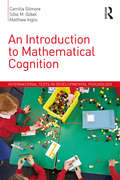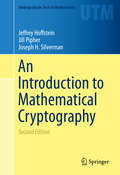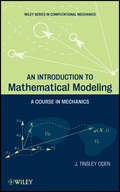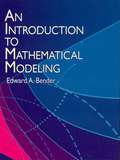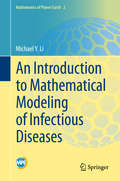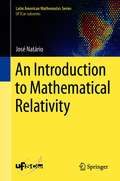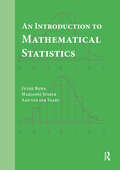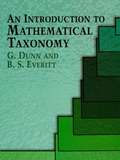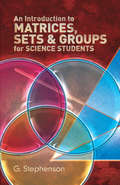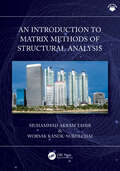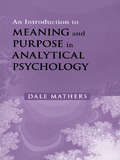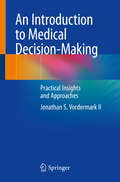- Table View
- List View
An Introduction to Mathematical Cognition (International Texts in Developmental Psychology)
by Camilla Gilmore Silke M. Göbel Matthew InglisThe last decade has seen a rapid growth in our understanding of the cognitive systems that underlie mathematical learning and performance, and an increased recognition of the importance of this topic. This book showcases international research on the most important cognitive issues that affect mathematical performance across a wide age range, from early childhood to adulthood. The book considers the foundational competencies of nonsymbolic and symbolic number processing before discussing arithmetic, conceptual understanding, individual differences and dyscalculia, algebra, number systems, reasoning and higher-level mathematics such as formal proof. Drawing on diverse methodology from behavioural experiments to brain imaging, each chapter discusses key theories and empirical findings and introduces key tasks used by researchers. The final chapter discusses challenges facing the future development of the field of mathematical cognition and reviews a set of open questions that mathematical cognition researchers should address to move the field forward. This book is ideal for undergraduate or graduate students of psychology, education, cognitive sciences, cognitive neuroscience and other academic and clinical audiences including mathematics educators and educational psychologists.
An Introduction to Mathematical Cryptography (Undergraduate Texts in Mathematics)
by Joseph H. Silverman Jeffrey Hoffstein Jill PipherThis self-contained introduction to modern cryptography emphasizes the mathematics behind the theory of public key cryptosystems and digital signature schemes. The book focuses on these key topics while developing the mathematical tools needed for the construction and security analysis of diverse cryptosystems. Only basic linear algebra is required of the reader; techniques from algebra, number theory, and probability are introduced and developed as required. This text provides an ideal introduction for mathematics and computer science students to the mathematical foundations of modern cryptography. The book includes an extensive bibliography and index; supplementary materials are available online. The book covers a variety of topics that are considered central to mathematical cryptography. Key topics include: classical cryptographic constructions, such as Diffie-Hellmann key exchange, discrete logarithm-based cryptosystems, the RSA cryptosystem, and digital signatures; fundamental mathematical tools for cryptography, including primality testing, factorization algorithms, probability theory, information theory, and collision algorithms; an in-depth treatment of important cryptographic innovations, such as elliptic curves, elliptic curve and pairing-based cryptography, lattices, lattice-based cryptography, and the NTRU cryptosystem. The second edition of An Introduction to Mathematical Cryptography includes a significant revision of the material on digital signatures, including an earlier introduction to RSA, Elgamal, and DSA signatures, and new material on lattice-based signatures and rejection sampling. Many sections have been rewritten or expanded for clarity, especially in the chapters on information theory, elliptic curves, and lattices, and the chapter of additional topics has been expanded to include sections on digital cash and homomorphic encryption. Numerous new exercises have been included.
An Introduction to Mathematical Epidemiology (Texts in Applied Mathematics #61)
by Maia MartchevaThe book is a comprehensive, self-contained introduction to the mathematical modeling and analysis of infectious diseases. It includes model building, fitting to data, local and global analysis techniques. Various types of deterministic dynamical models are considered: ordinary differential equation models, delay-differential equation models, difference equation models, age-structured PDE models and diffusion models. It includes various techniques for the computation of the basic reproduction number as well as approaches to the epidemiological interpretation of the reproduction number. MATLAB code is included to facilitate the data fitting and the simulation with age-structured models.
An Introduction to Mathematical Finance with Applications: Understanding and Building Financial Intuition (Springer Undergraduate Texts in Mathematics and Technology)
by Arlie O. Petters Xiaoying DongThis textbook aims to fill the gap between those that offer a theoretical treatment without many applications and those that present and apply formulas without appropriately deriving them. The balance achieved will give readers a fundamental understanding of key financial ideas and tools that form the basis for building realistic models, including those that may become proprietary. Numerous carefully chosen examples and exercises reinforce the student's conceptual understanding and facility with applications. The exercises are divided into conceptual, application-based, and theoretical problems, which probe the material deeper. The book is aimed toward advanced undergraduates and first-year graduate students who are new to finance or want a more rigorous treatment of the mathematical models used within. While no background in finance is assumed, prerequisite math courses include multivariable calculus, probability, and linear algebra. The authors introduce additional mathematical tools as needed. The entire textbook is appropriate for a single year-long course on introductory mathematical finance. The self-contained design of the text allows for instructor flexibility in topics courses and those focusing on financial derivatives. Moreover, the text is useful for mathematicians, physicists, and engineers who want to learn finance via an approach that builds their financial intuition and is explicit about model building, as well as business school students who want a treatment of finance that is deeper but not overly theoretical.
An Introduction to Mathematical Modeling
by J. Tinsley OdenA modern approach to mathematical modeling, featuring unique applications from the field of mechanics An Introduction to Mathematical Modeling: A Course in Mechanics is designed to survey the mathematical models that form the foundations of modern science and incorporates examples that illustrate how the most successful models arise from basic principles in modern and classical mathematical physics. Written by a world authority on mathematical theory and computational mechanics, the book presents an account of continuum mechanics, electromagnetic field theory, quantum mechanics, and statistical mechanics for readers with varied backgrounds in engineering, computer science, mathematics, and physics. The author streamlines a comprehensive understanding of the topic in three clearly organized sections: Nonlinear Continuum Mechanics introduces kinematics as well as force and stress in deformable bodies; mass and momentum; balance of linear and angular momentum; conservation of energy; and constitutive equations Electromagnetic Field Theory and Quantum Mechanics contains a brief account of electromagnetic wave theory and Maxwell's equations as well as an introductory account of quantum mechanics with related topics including ab initio methods and Spin and Pauli's principles Statistical Mechanics presents an introduction to statistical mechanics of systems in thermodynamic equilibrium as well as continuum mechanics, quantum mechanics, and molecular dynamics Each part of the book concludes with exercise sets that allow readers to test their understanding of the presented material. Key theorems and fundamental equations are highlighted throughout, and an extensive bibliography outlines resources for further study. Extensively class-tested to ensure an accessible presentation, An Introduction to Mathematical Modeling is an excellent book for courses on introductory mathematical modeling and statistical mechanics at the upper-undergraduate and graduate levels. The book also serves as a valuable reference for professionals working in the areas of modeling and simulation, physics, and computational engineering.
An Introduction to Mathematical Modeling (Dover Books on Computer Science)
by Edward A. BenderEmploying a practical, "learn by doing" approach, this first-rate text fosters the development of the skills beyond the pure mathematics needed to set up and manipulate mathematical models. The author draws on a diversity of fields -- including science, engineering, and operations research -- to provide over 100 reality-based examples. Students learn from the examples by applying mathematical methods to formulate, analyze, and criticize models. Extensive documentation, consisting of over 150 references, supplements the models, encouraging further research on models of particular interest. The lively and accessible text requires only minimal scientific background. Designed for senior college or beginning graduate-level students, it assumes only elementary calculus and basic probability theory for the first part, and ordinary differential equations and continuous probability for the second section. All problems require students to study and create models, encouraging their active participation rather than a mechanical approach. Beyond the classroom, this volume will prove interesting and rewarding to anyone concerned with the development of mathematical models or the application of modeling to problem solving in a wide array of applications.
An Introduction to Mathematical Modeling of Infectious Diseases (Mathematics of Planet Earth #2)
by Michael Y. LiThis text provides essential modeling skills and methodology for the study of infectious diseases through a one-semester modeling course or directed individual studies. The book includes mathematical descriptions of epidemiological concepts, and uses classic epidemic models to introduce different mathematical methods in model analysis. Matlab codes are also included for numerical implementations. It is primarily written for upper undergraduate and beginning graduate students in mathematical sciences who have an interest in mathematical modeling of infectious diseases. Although written in a rigorous mathematical manner, the style is not unfriendly to non-mathematicians.
An Introduction to Mathematical Population Dynamics: Along the trail of Volterra and Lotka (UNITEXT #79)
by Mimmo Iannelli Andrea PuglieseThis book is an introduction to mathematical biology for students with no experience in biology, but who have some mathematical background. The work is focused on population dynamics and ecology, following a tradition that goes back to Lotka and Volterra, and includes a part devoted to the spread of infectious diseases, a field where mathematical modeling is extremely popular. These themes are used as the area where to understand different types of mathematical modeling and the possible meaning of qualitative agreement of modeling with data. The book also includes a collections of problems designed to approach more advanced questions. This material has been used in the courses at the University of Trento, directed at students in their fourth year of studies in Mathematics. It can also be used as a reference as it provides up-to-date developments in several areas.
An Introduction to Mathematical Proofs (Textbooks in Mathematics)
by Nicholas A. LoehrAn Introduction to Mathematical Proofs presents fundamental material on logic, proof methods, set theory, number theory, relations, functions, cardinality, and the real number system. The text uses a methodical, detailed, and highly structured approach to proof techniques and related topics. No prerequisites are needed beyond high-school algebra. New material is presented in small chunks that are easy for beginners to digest. The author offers a friendly style without sacrificing mathematical rigor. Ideas are developed through motivating examples, precise definitions, carefully stated theorems, clear proofs, and a continual review of preceding topics. Features Study aids including section summaries and over 1100 exercises Careful coverage of individual proof-writing skills Proof annotations and structural outlines clarify tricky steps in proofs Thorough treatment of multiple quantifiers and their role in proofs Unified explanation of recursive definitions and induction proofs, with applications to greatest common divisors and prime factorizations About the Author: Nicholas A. Loehr is an associate professor of mathematics at Virginia Technical University. He has taught at College of William and Mary, United States Naval Academy, and University of Pennsylvania. He has won many teaching awards at three different schools. He has published over 50 journal articles. He also authored three other books for CRC Press, including Combinatorics, Second Edition, and Advanced Linear Algebra.
An Introduction to Mathematical Reasoning
by Peter J. EcclesThis book eases students into the rigors of university mathematics. The emphasis is on understanding and constructing proofs and writing clear mathematics. The author achieves this by exploring set theory, combinatorics, and number theory, topics that include many fundamental ideas and may not be a part of a young mathematician's toolkit. This material illustrates how familiar ideas can be formulated rigorously, provides examples demonstrating a wide range of basic methods of proof, and includes some of the all-time-great classic proofs. The book presents mathematics as a continually developing subject. Material meeting the needs of readers from a wide range of backgrounds is included. The over 250 problems include questions to interest and challenge the most able student but also plenty of routine exercises to help familiarize the reader with the basic ideas.
An Introduction to Mathematical Relativity (Latin American Mathematics Series)
by José NatárioThis concise textbook introduces the reader to advanced mathematical aspects of general relativity, covering topics like Penrose diagrams, causality theory, singularity theorems, the Cauchy problem for the Einstein equations, the positive mass theorem, and the laws of black hole thermodynamics. It emerged from lecture notes originally conceived for a one-semester course in Mathematical Relativity which has been taught at the Instituto Superior Técnico (University of Lisbon, Portugal) since 2010 to Masters and Doctorate students in Mathematics and Physics. Mostly self-contained, and mathematically rigorous, this book can be appealing to graduate students in Mathematics or Physics seeking specialization in general relativity, geometry or partial differential equations. Prerequisites include proficiency in differential geometry and the basic principles of relativity. Readers who are familiar with special relativity and have taken a course either in Riemannian geometry (for students of Mathematics) or in general relativity (for those in Physics) can benefit from this book.
An Introduction to Mathematical Statistics
by Fetsje Bijma Marianne Jonker Aad VaartStatistics is the science that focuses on drawing conclusions from data, by modeling and analyzing the data using probabilistic models. In 'An Introduction to Mathematical Statistics' the authors describe key concepts from statistics and give a mathematical basis for important statistical methods. Much attention is paid to the sound application of those methods to data. The three main topics in statistics are estimators, tests, and confidence regions. The authors illustrate these in many examples, with a separate chapter on regression models, including linear regression and analysis of variance. They also discuss the optimality of estimators and tests, as well as the selection of the best-fitting model.Each chapter ends with a case study in which the described statistical methods are applied. This book assumes a basic knowledge of probability theory, calculus, and linear algebra.
An Introduction to Mathematical Taxonomy (Dover Books on Biology)
by B. S. Everitt G. DunnStudents of mathematical biology discover modern methods of taxonomy with this text, which introduces taxonomic characters, the measurement of similarity, and the analysis of principal components. Other topics include multidimensional scaling, cluster analysis, identification and assignment techniques, more. A familiarity with matrix algebra and elementary statistics are the sole prerequisites.
An Introduction to Mathematics (Dover Books on Mathematics)
by Alfred North Whitehead"The object of the following chapters is not to teach mathematics, but to enable students from the very beginning of their course to know what the science is about, and why it is necessarily the foundation of exact thought as applied to natural phenomena." Thus begins this volume by the prominent English philosopher and mathematician Alfred North Whitehead, a concise statement on the nature and meaning of mathematics for the general student. Expertly written and abounding in insights, the book presents a lively exposition of mathematical concepts, the history of their development, and their applications to the physical world. Whitehead explains in broad terms what mathematics is about, what it does, and how mathematicians do it.Generations of readers who have stayed with the philosopher from the beginning to the end have found themselves amply rewarded for taking this journey.
An Introduction to Mathematics for Economics
by Akihito AsanoAn Introduction to Mathematics for Economics introduces quantitative methods to students of economics and finance in a succinct and accessible style. The introductory nature of this textbook means a background in economics is not essential, as it aims to help students appreciate that learning mathematics is relevant to their overall understanding of the subject. Economic and financial applications are explained in detail before students learn how mathematics can be used, enabling students to learn how to put mathematics into practice. Starting with a revision of basic mathematical principles the second half of the book introduces calculus, emphasising economic applications throughout. Appendices on matrix algebra and difference/differential equations are included for the benefit of more advanced students. Other features, including worked examples and exercises, help to underpin the readers' knowledge and learning. Akihito Asano has drawn upon his own extensive teaching experience to create an unintimidating yet rigorous textbook.
An Introduction to Mathematics for Engineers: Mechanics
by Stephen LeeThis new introductory mechanics textbook is written for engineering students within further and higher education who are looking to bridge the gap between A-Level and university or college.
An Introduction to Matrices, Sets and Groups for Science Students
by G. StephensonThis outstanding text offers undergraduate students of physics, chemistry, and engineering a concise, readable introduction to matrices, sets, and groups. Concentrating mainly on matrix theory, the book is virtually self-contained, requiring a minimum of mathematical knowledge and providing all the background necessary to develop a thorough comprehension of the subject. Beginning with a chapter on sets, mappings, and transformations, the treatment advances to considerations of matrix algebra, inverse and related matrices, and systems of linear algebraic equations. Additional topics include eigenvalues and eigenvectors, diagonalisation and functions of matrices, and group theory. Each chapter contains a selection of worked examples and many problems with answers, enabling readers to test their understanding and ability to apply concepts.
An Introduction to Matrix Methods of Structural Analysis
by Muhammad Akram Tahir Worsak Kanok-NukulchaiThe matrix force method has been systematically developed for the analysis of beam and frame structures. It helps develop the matrix stiffness method from a basic spring element, and this is extended to the analysis of beams, trusses, plain frames, grillages, and space frames.Using computer programs (manual, automatic, or the direct force method extending toward automation), this book interactively introduces matrix methods of structural analysis. In addition to work and energy, it also discusses the concepts of stresses, strains, strain displacement relationship, and plain stress and strain. Features: Explains force, displacement, and stiffness via the matrix perspective. Reviews full programming code for each problem. Provides the modern concepts of force method that leads toward automation of the force method, such as the direct stiffness method. Discusses effect of temperatures exclusively. Includes the macro language Matrix Analysis Interpretive Language (MAIL) as an extension of analysis interpretive treatise with examples, exercises, PowerPoint slides, and illustrative problems. The MAIL executable, guide, and codes are provided on the website of the book. This book is aimed at senior undergraduate and postgraduate students in structural engineering.
An Introduction to Meaning and Purpose in Analytical Psychology
by Dale MathersThis highly original book examines the relationship between analytical psychology and meaning, interpreting human suffering as arising from meaning disorders. Using clinical examples - whether people trapped in patterns of dependence, suffering from psychosomatic diseases, or with personality problems - it shows how, by treating clients' issues as failures of the meaning-making process, one can help them change their own own personal meaning. An Introduction to Meaning and Purpose in Analytical Psychology will make provocative reading for all those in helping professions, including counsellors, psychotherapists, and psychiatrists.
An Introduction to Mechanics
by Daniel Kleppner Robert J. KolenkowIn the years since it was first published in 1973 by McGraw-Hill, this classic introductory textbook has established itself as one of the best-known and most highly regarded descriptions of Newtonian mechanics. Intended for undergraduate students with foundation skills in mathematics and a deep interest in physics, it systematically lays out the principles of mechanics: vectors, Newton's laws, momentum, energy, rotational motion, angular momentum and noninertial systems, and includes chapters on central force motion, the harmonic oscillator, and relativity. Numerous worked examples demonstrate how the principles can be applied to a wide range of physical situations, and more than 600 figures illustrate methods for approaching physical problems. The book also contains over 200 challenging problems to help the student develop a strong understanding of the subject. Password-protected solutions are available for instructors at www.cambridge.org/9780521198219.
An Introduction to Medical Dance/Movement Therapy: Health Care in Motion
by Sharon W. GoodillPresenting dance/movement therapy (DMT) as a viable and valuable psychosocial support service for those with a medical illness, Sharon W. Goodill shows how working creatively with the mind/body connection can encourage and enhance the healing process. This book represents the first attempt to compile, synthesize, and publish the work that has been done over recent years in medical DMT. The emerging application of medical DMT is grounded within the context of established viewpoints and theories, such as arts therapies, health psychology and scientific perspectives. As well as examining its theoretical foundations, the author offers real-life examples of medical DMT working with people of different ages with different medical conditions. This comprehensive book provides a firm foundation for exploration and practice in medical DMT, including recommendations for professional preparation, research and program development. Interviews with dance/movement therapists bring fresh and exciting perspectives to the field and these and the author's testimonies point to the possible future applications of medical DMT. With an increasing number of professional dance/movement therapists working with the medically ill and their families, this is a timely and well-grounded look at an exciting new discipline. It is recommended reading for DMT students and professionals, complementary therapists, and all those with an interest in the healing potential of working innovatively with the mind and body.
An Introduction to Medical Decision-Making: Practical Insights and Approaches
by Jonathan S. Vordermark IIThis volume presents novel concepts to help physicians and health care providers better understand the thought processes and approaches used in clinical decision-making and how we develop those skills as we transition from being a medical student to post-graduate trainee to independent practitioner. Approaches presented range from simple rules of thumb, pattern recognition, and heuristics, to more formulaic methods such as standard operating procedures, checklists, evidence-based medicine, mathematical modeling, and statistics. Ways to recognize and manage errors and how our decision-making can be improved, are also discussed.An Introduction to Medical Decision-Making presents several innovative techniques to allow the reader to use the principles presented and integrate the ethical, humanistic and social aspects of decision-making with the pragmatic and knowledge-based aspects of clinical medicine. It also highlights how our thinking processes, emotions, and biases affect decision-making. This invaluable resource will allow students and physicians to evaluate and critically discuss their decisions objectively to become more efficient and effective, and maximize the quality of care they provide.
An Introduction to Medical Leadership for Surgeons: Maximizing Interpersonal Interactions for Success
by Stanley Zackary TrooskinHistorically, there has been a dearth of leadership instruction specifically designed for surgeons early in their careers, including the resident and junior attending levels, as well as for senior surgeons. Utilizing over 40 years of personal experience, this book focuses on applying the modern teaching tenets of medical leadership, illustrating them with the author's engaging stories as a surgeon, medical director and department chair - both what did and what did not work. Chapters are targeted for the specific issues related to the various stages of a surgical career, with the focus on maximizing successful personal interactions with peers, staff, and superiors. Consistently highlighting the benefits of emotional intelligence, as well as skills in managing up, down and sideways, the topics addressed include basic principles of medical leadership, clinical team leading for residents, operative leadership for new surgeons, successful committee participation, medical school leadership, and both elected and administrative hospital leadership. Selected chapters conclude with "Lessons Learned" - concise summaries of the key points of each chapter for easy reference.Written in both a personal and professional voice, An Introduction to Medical Leadership for Surgeons is an excellent resource for surgeons looking to lead at all levels of their career.
An Introduction to Medical Physics (Biological and Medical Physics, Biomedical Engineering)
by Muhammed MaqboolThis book begins with the basic terms and definitions and takes a student, step by step, through all areas of medical physics. The book covers radiation therapy, diagnostic radiology, dosimetry, radiation shielding, and nuclear medicine, all at a level suitable for undergraduates. This title not only describes the basics concepts of the field, but also emphasizes numerical and mathematical problems and examples. Students will find An Introduction to Medical Physics to be an indispensible resource in preparations for further graduate studies in the field.
An Introduction to Medical Sociology (Social Science Paperbacks Ser.)
by David TuckettTavistock Press was established as a co-operative venture between the Tavistock Institute and Routledge & Kegan Paul (RKP) in the 1950s to produce a series of major contributions across the social sciences. This volume is part of a 2001 reissue of a selection of those important works which have since gone out of print, or are difficult to locate. Published by Routledge, 112 volumes in total are being brought together under the name The International Behavioural and Social Sciences Library: Classics from the Tavistock Press. Reproduced here in facsimile, this volume was originally published in 1976 and is available individually. The collection is also available in a number of themed mini-sets of between 5 and 13 volumes, or as a complete collection.
